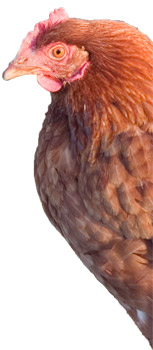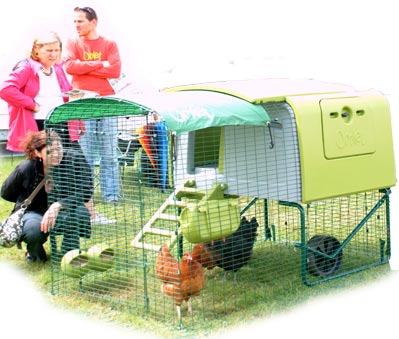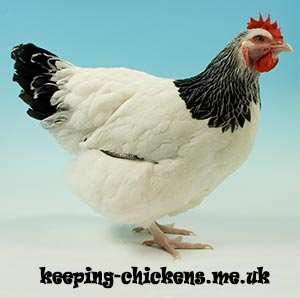Keeping a few chickens in the back yard really is quite straight forward; however there are some things to consider in order to get the right sort of birds for your situation and to keep them in the best possible health to get the most enjoyment out of keeping them.
This page hopes to get you thinking about the types of chickens and their requirements.
Choosing a breed
There are quite literally hundreds of different breeds of chicken to choose from and out of these, many have slightly different requirements.
Some breeds of chicken come only as Large Fowl, and others are also available as Bantams which are a smaller version that look the same. The Orpington for example is available in both large and bantam sizes but the Cochin is only available as large fowl.
There are a handful of ‘True Bantams’ where there is no large fowl equivalent. Examples of these are Dutch Bantams, Japanese Bantams and the popular Pekin Bantam.
Bantams tend to be quite flighty whereas the heavy breeds of large fowl often cannot fly more than a few inches off the ground. Orpingtons for example won’t usually roost very high due to their huge size and will usually just huddle on the floor of the coop.
Every breed is slightly different in the amount of eggs they lay. Typically hens that have been bred for exhibition purposes do not lay as well as utility hens. Bantams of course lay smaller eggs which some people say they prefer for taste.
Hybrids
 Hybrids are chickens that have been created by crossing pure breeds. They are typically crossed to make good layers (the hybrid to the right can lay 280 to 300 eggs!), coloured eggs or attractive hens. Some can be very attractive and they are all generally very hardy. Hybrids are produced in larger numbers that pure breeds and most of the crosses used make the males a different colour as day old chicks so that only females can be raised, therefore reducing costs by about half. A typical hybrid hen will cost you around £15 compare to £25 to £30 for a typical pure breed hen.
Hybrids are chickens that have been created by crossing pure breeds. They are typically crossed to make good layers (the hybrid to the right can lay 280 to 300 eggs!), coloured eggs or attractive hens. Some can be very attractive and they are all generally very hardy. Hybrids are produced in larger numbers that pure breeds and most of the crosses used make the males a different colour as day old chicks so that only females can be raised, therefore reducing costs by about half. A typical hybrid hen will cost you around £15 compare to £25 to £30 for a typical pure breed hen.
Hybrids are a good choice if eggs are one of your priorities although if you think you might like to hatch some eggs, remember hybrid hens do not breed true – you would need the original pure breeds to cross again in order to create more of the same thing so whilst you can hatch their eggs, you may want to consider a few pure breeds for this purpose or consider buying in eggs to hatch.
Free Range
You will of course need a chicken coop but also a secure run or area that is predator proof. A question that people always ask me is “How big should their run be?” I always say “as big as possible within reason.” Even 2 chickens kept in a 2 meter run will soon turn it to mud and get bored (which can introduce vices such as feather pecking and egg eating) but I always believe that it’s fine to provide a small run like this if you can let them out for a few hours each day to free range while you are around. This will give them a chance to forage, supplement their diet and reduce boredom.
Once chickens have settled into their new house, they will go back to it to roost every night so you can let them out in the late afternoon, knowing they will come back to roost at night keeping everyone happy! Some houses and runs have handles or wheels that make them easy to move onto fresh ground which is not only good to prevent a build up of worm eggs and disease but also provides them with a little fresh grass to graze.
Keeping Chickens in the Garden
If you have a ‘nice’ garden that you don’t want spoilt, it’s usually a sensible idea to limit their foraging. Chickens scratch at the ground, make dust baths in the dry soil, leave muck wherever they go and destroy tender young plants. If you can plant in pots, this will help and fencing off part of the garden is usually a good choice to keep them out if you have tender or precious plants. Chickens with feathered feet scratch less and bantams can clear a 6 foot fence if they want to. Heavy breeds of large fowl can be kept out with a knee high fence or box hedge. If you want to stop a bird from flying then you can clip one wing (not both).
So you have decided on the breed that’s right for you and your circumstances. Next, you will need to think about keeping them secure from predators in a suitable chicken house and chicken run – click on a link to go to that page!








Hi me and my family just got a new house with a nice sized garden and we want to keep maybe 3-4 hens for eggs and to keep the children entertained but were don’t know ANYTHING about keeping chickens or how to pick them up so do you have any ides?
and also what are the best hens/chickens for this.
Hybrids are your best bet for ‘tame’ chickens that can be picked up by children but make sure they are supervised at all times as they can struggle if not held securely and scratch unintentionally as they do.
I live in spain and want to start keeping chickens for eggs.
we have a large area with a wall closed in and want to keep the chickens there, we dont want to clip their wings but am worried they will fly away
we have a room for them to lay eggs and sleep in at night, a water supply, dirt, grass and flowers for them to scratch in and trees for them to roost in also
will this be okay for them
thanks
clare
Chickens can’t sweat so cool down by drinking lots of water and passing more fluids out in their droppings to get rid of heat. They will also pant when over heated. It’s very important that they have fresh water at all times – keep their water in the shade so it does not get too hot which will help them to cool down. Ideally give them fresh (cool) water in the hottest part of the day. If the room is a stone / brick building, hopefully this will provide suitable shade / cool area for them.
Bantams and Mediteranean breeds can fly well but heavier breeds aren’t good fliers. Check the breed characteristics before you buy to see if they can fly well or not.
Many thanks for a great place for beginners, there is some great advice on the pages which puts certain worries at ease. I have put your site in my favourites as I will need to re-read the pages again.
Once again thanks for the advice that will save me time and money.
Hi, You have a fantastic website – thank you so much for all the useful information. I want to keep chickens but have 4ft fences. I’d like my girls to be free to wander around – is there a particular breed you’d recommend who aren’t flightey but are friendly and good layers? I was considering Hybrids – if these are suitable do I need to clip wings? Many thanks
Heavy breeds won’t fly – Orpingtons being a classic… Light Sussex etc
My fences are chest height and hens stay in once they are used to the area. You can clip one wing (primary feathers only) to unbalance an escape artist..
Love this site its so helpful, I have 3 chickens 2 are x batery, how long do chickens live for.
please can you tell me what is wrong with two of my chickens its poo is very runny its like diareha and they have stopped laying
Are they wormed?
There are many, many diseases that can cause the runs and a number of other things such as diet, antibiotics and so on. If it doesn’t clear, I would take one to the vet for testing.